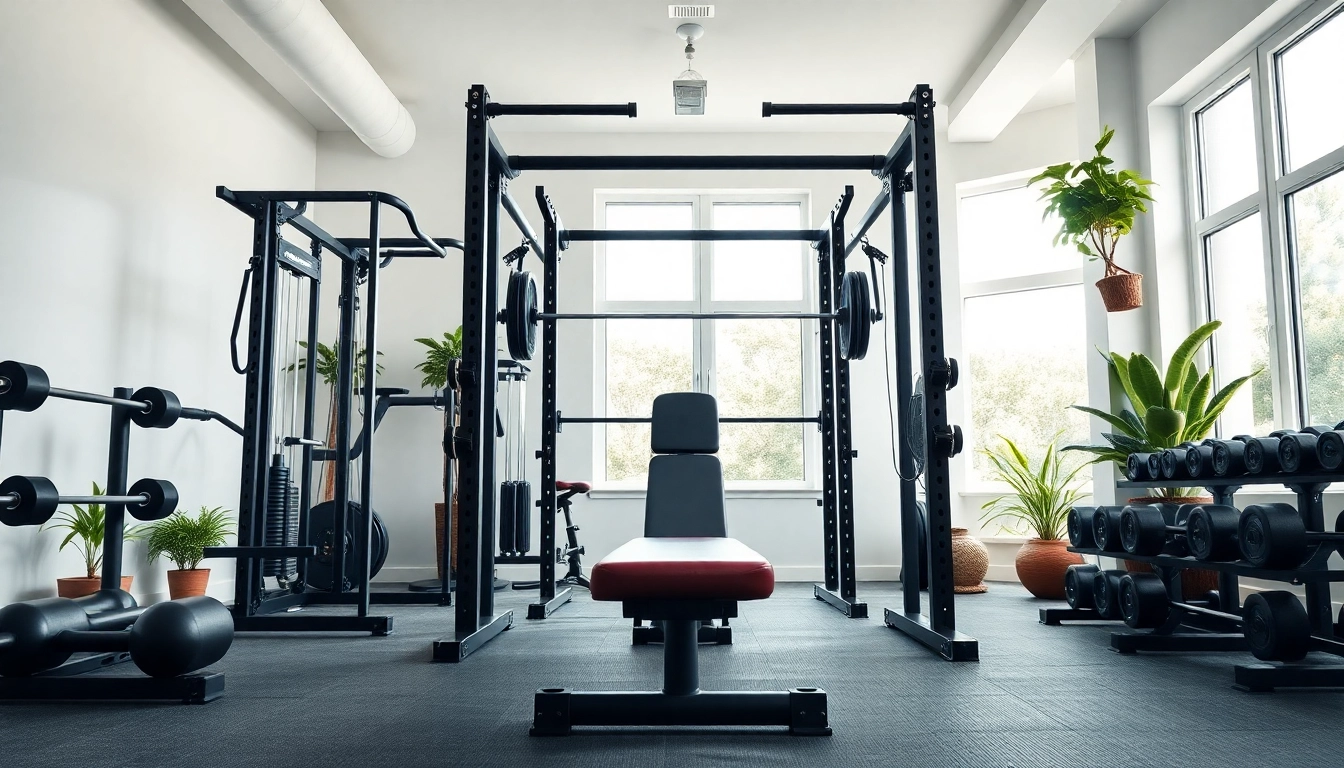Introduction to Home Gym Equipment
In recent years, the trend of setting up personal fitness spaces at home has surged. As people become more health-conscious and prioritize their well-being, the demand for home gym equipment has soared. This shift toward home workouts allows individuals to exercise in the comfort of their own space, catering to varied schedules and preferences. This article explores the intricacies of home gym equipment, presenting valuable insights for anyone looking to establish their fitness sanctuary.
Benefits of Having Home Gym Equipment
Investing in home gym equipment provides numerous benefits that extend beyond mere convenience. Here are key advantages:
- Convenience: Home gyms eliminate the need to commute, allowing for flexibility in workout timing.
- Cost Efficiency: While the initial investment may be hefty, over time it often proves cheaper than a continuous gym membership.
- Privacy: Exercising at home offers a space for beginners to learn without the intimidation often felt in a traditional gym environment.
- Customization: Owners can select equipment that suits personal fitness goals without compromises.
- Family Access: Home gyms can cater to various fitness levels and preferences, providing an all-in-one solution for families.
Choosing the Right Size and Space for Your Home Gym Equipment
Deciding on the size and space for a home gym is essential for creating an effective workout environment. Here are guidelines to consider:
- Assess Available Space: Identify a specific area in your home, such as a spare room, garage, or even a deck. Measure this space to determine what equipment can fit comfortably.
- Consider Ceiling Height: Make sure there’s enough vertical space for exercises involving weights or vertical machines.
- Plan the Layout: Arrange equipment in a manner that promotes flow and accessibility – ensure ample space for movement around each piece of equipment.
Understanding Basic Components of Home Gym Equipment
Home gym equipment can vary significantly, but understanding its basic components is crucial for selecting the right pieces for your goals:
- Cardio Equipment: Devices like treadmills, ellipticals, and stationary bikes are fundamental for cardiovascular health.
- Strength Training Equipment: This includes weights, resistance bands, and machines aimed at building muscle strength.
- Functional Accessories: Items such as mats, foam rollers, and balance balls enhance functionality and safety in workouts.
Types of Home Gym Equipment
Strength Training Equipment Explained
Strength training is paramount for improving muscular strength, endurance, and overall body composition. Essential pieces include:
- Dumbbells: Versatile and ideal for performing various exercises targeting different muscle groups.
- Kettlebells: These are excellent for dynamic movements that build strength as well as cardiovascular endurance.
- Barbells and Weight Plates: A barbell setup allows for heavier lifts and more advanced strength training.
- Resistance Bands: Affordable and portable, great for strength training without bulky equipment.
Cardio Machines for Home Gyms
Cardiovascular fitness is a cornerstone of any workout routine. Consider incorporating these machines:
- Treadmills: Great for running or walking indoors and often include features like incline settings for advanced workouts.
- Rowing Machines: Provide a full-body workout and are excellent for improving cardiovascular health.
- Stationary Bikes: Perfect for low-impact cardio; options include upright and recumbent styles.
- Ellipticals: Combine upper and lower body workouts while minimizing impact on joints.
Essential Accessories for Your Home Gym Equipment
Accessories may often be overlooked but can significantly enhance the workout experience:
- Yoga Mats: Vital for activities like yoga, pilates, or any floor exercises to prevent slipping and provide cushioning.
- Foam Rollers: Essential for post-workout recovery, helping relieve muscle soreness and tightness.
- Storage Solutions: Racks and bins can help keep your equipment organized and safe.
- Mirrors: Useful for checking form and technique during workouts.
Setting Up Your Home Gym Equipment
Designing a Functional Gym Layout
The layout of your home gym can affect your motivation and effectiveness. Consider these design tips:
- Zoning: Create zones for different workout types (e.g., cardio area, strength area).
- Workbench: Include a space for stretching or body weight exercises with adequate floor space.
- Ventilation and Lighting: Good airflow and ample lighting will create a pleasant environment.
Optimal Equipment Arrangement for Space Efficiency
Arranging equipment efficiently can maximize space utilization:
- Vertical Storage: Utilize wall-mounted shelves or racks to keep equipment off the floor.
- Multi-Purpose Equipment: Consider machines that offer multiple workout options to save on space.
- Clear Pathways: Ensure that there are no obstructions between pieces of equipment to maintain a smooth workout flow.
Safety Tips for Your Home Gym Equipment Setup
Ensuring safety in your home gym is fundamental:
- Proper Setup: Follow instructions for setup and adjustment of equipment.
- Maintain Your Equipment: Regularly check equipment for wear and tear to prevent accidents.
- Use a Spotter: For heavy lifts, have someone check your form or assist you for safety.
Maximizing Effectiveness of Home Gym Equipment
Creating a Balanced Workout Routine
A balanced workout routine should incorporate various elements of fitness:
- Strength Training: Aim for at least two days per week, targeting major muscle groups.
- Cardiovascular Exercise: Include 150 minutes of moderate or 75 minutes of vigorous activity weekly.
- Flexibility and Mobility Work: Incorporate stretching to improve range of motion and prevent injuries.
Tracking Progress with Home Gym Equipment
Monitoring your progress can enhance motivation and provide a clear picture of your fitness journey:
- Fitness Journals: Document workouts, weights, and durations to see progress over time.
- Wearables: Utilize fitness trackers to monitor heart rate, calories burned, and overall fitness levels.
- Performance Metrics: Set specific goals (e.g., lifting a certain weight, completing a distance) to track improvements.
Common Mistakes to Avoid with Home Gym Equipment
Many home gym users make mistakes that hinder effectiveness:
- Lack of Variety: Avoid sticking to the same routine; switch up exercises to engage different muscle groups.
- Skipping Warm-ups: Always start with a proper warm-up to prepare the body and reduce injury risk.
- Ignoring Recovery: Give your body time to recuperate to prevent overtraining and burnout.
Conclusion: Building Your Ideal Home Gym Equipment
Long-Term Maintenance of Home Gym Equipment
Ensuring that equipment remains functional requires ongoing maintenance:
- Regular Cleaning: Wipe down machines and weights after use to prevent rust and damage.
- Scheduled Inspections: Check cables, connections, and moving parts periodically to ensure they are in working order.
- Follow Manufacturer Guidelines: Adhere to maintenance protocols as outlined in the user manuals.
Adapting Your Gym as Fitness Levels Change
Your fitness level is likely to evolve, requiring adjustments to your home gym setup:
- Upgrade Equipment: As you progress, add equipment that supports advanced techniques and heavier weights.
- Change Layout: Modify your gym setup when introducing new equipment to maximize efficiency.
- Explore New Workout Styles: As you grow, consider classes or combinations of fitness styles to keep workouts engaging.
Community and Support for Home Gym Equipment Enthusiasts
Joining a community can enhance your fitness journey:
- Online Forums and Social Media: Sharing challenges and successes with others can increase accountability and motivation.
- Local Fitness Groups: Engage with others in your area who share similar fitness goals for support and encouragement.
- Workshops and Classes: Participate in workshops to learn new techniques and get expert advice on using your home gym equipment effectively.














Leave a Reply